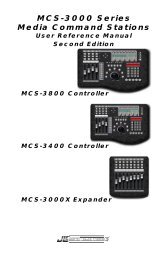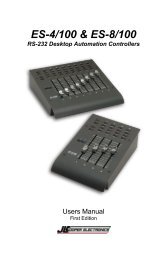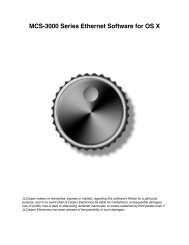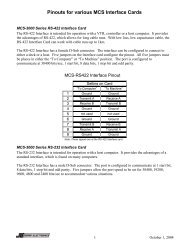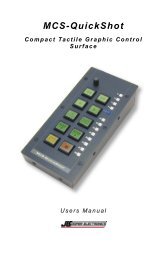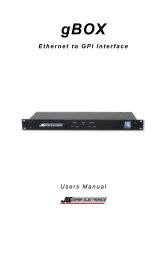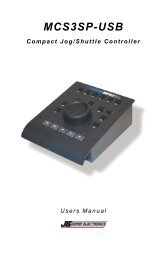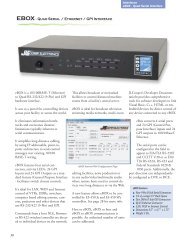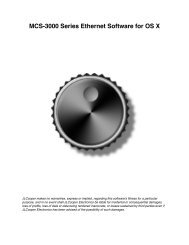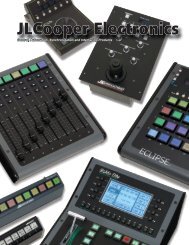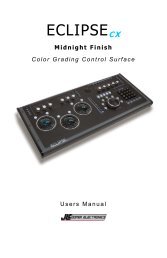MCS3 SP USB Software for OS X - JLCooper Electronics
MCS3 SP USB Software for OS X - JLCooper Electronics
MCS3 SP USB Software for OS X - JLCooper Electronics
- No tags were found...
Create successful ePaper yourself
Turn your PDF publications into a flip-book with our unique Google optimized e-Paper software.
<strong>MCS3</strong> <strong>SP</strong> <strong>USB</strong> <strong>Software</strong> <strong>for</strong> <strong>OS</strong>X<strong>JLCooper</strong> makes no warranties, express or implied, regarding this softwareʼs fitness <strong>for</strong> a particularpurpose, and in no event shall <strong>JLCooper</strong> <strong>Electronics</strong> be liable <strong>for</strong> incidental or consequential damages,loss of profits, loss of data or data being rendered inaccurate, or losses sustained by third parties even if<strong>JLCooper</strong> <strong>Electronics</strong> has been advised of the possibility of such damages.
INSTALLATION..................................................................................... 1UNINSTALLING.................................................................................... 2SYSTEM AND SOFTWARE SETUP.......................................................... 2INTRODUCTION TO THE <strong>MCS3</strong> <strong>SP</strong> <strong>USB</strong> SOFTWARE.............................. 3KEYSETS................................................................................................... 3EDITING KEYSETS ..............................................................................4THE IN<strong>SP</strong>ECTOR WINDOW ...................................................................5ACTION TABS .....................................................................................7KEYSTROKES TAB...................................................................................... 7MOUSE TAB ............................................................................................11MIDI TAB ................................................................................................16EMULATION TAB....................................................................................... 20<strong>SP</strong>ECIAL TAB ...........................................................................................23BUILT IN ACTIONS TAB .............................................................................24FINAL CUT PRO SUPPORT .............................................................25FINAL CUT PRO AND CONTROL SURFACES............................................. 25FINAL CUT PRO SHUTTLE .....................................................................25USING THE <strong>MCS3</strong> <strong>SP</strong> WITH FINAL CUT PRO ..........................................25THE <strong>MCS3</strong> <strong>SP</strong> FINAL CUT PRO KEYSET ...................................................26SOUNDTRACK PRO SUPPORT ........................................................30THE SOUNDTRACK PRO KEYSET............................................................... 30GARAGEBAND SUPPORT ...............................................................33THE GARAGEBAND KEYSET...................................................................... 33IMOVIE SUPPORT.......................................................................... 35THE IMOVIE KEYSET ................................................................................35LOGIC SUPPORT ...........................................................................37THE LOGIC KEYSET.................................................................................. 37NUENDO SUPPORT .......................................................................39THE NUENDO KEYSET.............................................................................. 39<strong>MCS3</strong> <strong>SP</strong> <strong>USB</strong> <strong>Software</strong>i
InstallationDouble-click the file Install_<strong>MCS3</strong>_<strong>SP</strong>_<strong>USB</strong>_3.x to open a disk image. From thewindow that opens, run the application Install <strong>MCS3</strong> <strong>SP</strong> <strong>USB</strong> 3.x and follow theonscreen instructions.The following files will be installed on your main hard drive:The folder <strong>MCS3</strong> <strong>SP</strong> <strong>USB</strong> <strong>Software</strong> will be placed in the /Applications/ folder. Thisfolder contains the <strong>MCS3</strong> <strong>SP</strong> <strong>USB</strong> application, keysets, and documentation.<strong>MCS3</strong><strong>SP</strong><strong>USB</strong>MIDIDriver.plugin will be placed in /Library/Audio/MIDIDrivers/.<strong>MCS3</strong> <strong>SP</strong> <strong>USB</strong> Uninstaller will be placed in /Library/StartupItems/.The folder <strong>JLCooper</strong> will be placed in /Library/Application Support.The <strong>MCS3</strong> <strong>SP</strong> <strong>USB</strong> Uninstaller application will be placed on the Desktop.After the installation is complete, you will be directed to restart your computer.<strong>MCS3</strong> <strong>SP</strong> <strong>USB</strong> <strong>Software</strong> 1
UninstallingLaunch the <strong>MCS3</strong> <strong>SP</strong> <strong>USB</strong> Uninstaller application which is located on the Desktop.Select the items you wish to uninstall (or click on the Select All checkbox) then click onthe Uninstall button.System and <strong>Software</strong> SetupThe <strong>MCS3</strong> <strong>SP</strong> software relies on Appleʼs Universal Access to per<strong>for</strong>m mouse emulation.In order <strong>for</strong> the <strong>MCS3</strong> <strong>SP</strong> software to work correctly, you must open SystemPreferences and go to the Universal Access pane. Make sure “Enable access <strong>for</strong>assistive devices” is checked then quit System Preferences.<strong>MCS3</strong> <strong>SP</strong> <strong>USB</strong> <strong>Software</strong> 2
Introduction to the <strong>MCS3</strong> <strong>SP</strong> <strong>USB</strong> <strong>Software</strong>The <strong>MCS3</strong> <strong>SP</strong> <strong>Software</strong> extends the <strong>MCS3</strong> <strong>SP</strong> hardwareʼs ability to control variousapplications running on your Macintosh. It does this by communicating withapplications via MIDI, <strong>USB</strong> and other messaging protocols built into the Mac <strong>OS</strong>. It canalso simulate mouse clicking and dragging, keystrokes and can even emulate othercontrol surfaces if necessary.KeysetsThe <strong>MCS3</strong> <strong>SP</strong> software uses “keysets” which are sets of various actions that are takenwhen <strong>MCS3</strong> <strong>SP</strong> controls are pressed or turned. Different keysets can be applied todifferent applications, and the <strong>MCS3</strong> <strong>SP</strong> software will choose the correct keyset <strong>for</strong>whichever application is in the <strong>for</strong>eground. If no keyset has been created <strong>for</strong> the current<strong>for</strong>eground application, the <strong>MCS3</strong> <strong>SP</strong> will use a built in keyset called the “Default”keyset.To create or edit <strong>MCS3</strong> <strong>SP</strong> keysets, open the application, <strong>MCS3</strong> <strong>SP</strong> <strong>USB</strong> (/Applications/<strong>MCS3</strong> <strong>SP</strong> <strong>USB</strong> <strong>Software</strong>/). To create a new keyset, choose NewKeyset in the File menu and navigate to the application that will use the new keyset.You can also use Import Keyset from the File Menu to get an existing keyset. Keysetsthat ship with the <strong>MCS3</strong> <strong>SP</strong> are located at /Applications/<strong>MCS3</strong> <strong>SP</strong> <strong>USB</strong><strong>Software</strong>/keysets/. You only need to use New Keyset or Import Keyset once <strong>for</strong> agiven application. After that, keysets are stored with the <strong>MCS3</strong> <strong>SP</strong> softwareʼspreferences.You can use Export Keyset from the File Menu to save a copy of a keyset so it can betransported to another Mac or archived <strong>for</strong> safekeeping. You donʼt need to use Export inyour daily use of the <strong>MCS3</strong>. As previously pointed out, your changes are added to the<strong>MCS3</strong> <strong>SP</strong> softwareʼs preferences file automatically.There are several sample keysets included in this package, including ones <strong>for</strong> Final CutPro and Soundtrack Pro.<strong>MCS3</strong> <strong>SP</strong> <strong>USB</strong> <strong>Software</strong> 3
Editing KeysetsThe application presents a graphical representation of the <strong>MCS3</strong> <strong>SP</strong> front panel. Whenyou click on an on-screen control (or move a control on the <strong>MCS3</strong> <strong>SP</strong> itself), that controlis selected and in<strong>for</strong>mation about it appears in the floating Inspector window.You can choose which keyset to edit within the <strong>MCS3</strong> <strong>SP</strong> <strong>USB</strong> application using theKeysets menu. The menu lists all keysets that you have created or imported. The nameof the currently selected keyset will be displayed at the bottom of the main window.<strong>MCS3</strong> <strong>SP</strong> <strong>USB</strong> <strong>Software</strong> 4
The Inspector WindowThe Inspector window is where all your work takes place. It displays in<strong>for</strong>mation aboutthe currently selected control and contains the facilities <strong>for</strong> editing that in<strong>for</strong>mation.The Name text box allows you to give a control a more descriptive name that describesits precise function. In the example above, the “Play” button has been assigned anaction that starts playback from the current time indicator, so naming the button “PlayFrom Current Time” conveys more in<strong>for</strong>mation than “Play”.If the selected control is a button, then immediately below the Name you will see a“Latched” checkbox that lets you choose between a momentary (pressing the buttonturns it “on”, releasing it turns it “off”) or latched (pressing and releasing it turns it “on”and pressing and releasing it a second time turns it “off”) behavior.<strong>MCS3</strong> <strong>SP</strong> <strong>USB</strong> <strong>Software</strong> 5
Next is a description of the action that is to take place when the selected <strong>MCS3</strong> <strong>SP</strong>control is pressed or turned while the target application is active. Below that is the areawhere this action can be edited. There are a series of tabs representing the differentkinds of actions that can be per<strong>for</strong>med. Clicking on one of these tabs will displaycontrols <strong>for</strong> editing its kind of action. The available actions are Built In, Keystrokes,Mouse, MIDI, Special and Emulation.Any changes made in one of these tabs are immediately applied to the selected control.The <strong>MCS3</strong> <strong>SP</strong> software allows multiple levels of Undo, so you can easily get back toany starting point.Also at the bottom of the Inspector window is the Delete Action button. When pressedit will delete the action currently assigned to the selected control. This is also undoable.The Inspector will show one additional control at the top when the Jog Wheel isselected- the Sensitivity Slider. Moving the slider to the right will make the Jog Wheelmore sensitive, and moving it to the left will make it less sensitive.<strong>MCS3</strong> <strong>SP</strong> <strong>USB</strong> <strong>Software</strong> 6
Action TabsKeystrokes TabThe <strong>MCS3</strong> <strong>SP</strong> controls can be assigned to send a sequence of keystrokes to anapplication just as if they were keys on the Mac keyboard. These assignments are setup in the Keystrokes Tab.Select a control to edit, place the cursor in the Keystroke field and type a key. If youhold down any modifier keys (command, shift, option or control) while typing this key,the modifier checkboxes will be set up accordingly. You can also manually change themodifier checkboxes by clicking on them.<strong>MCS3</strong> <strong>SP</strong> <strong>USB</strong> <strong>Software</strong> 7
Some key/modifier combinations may be intercepted by the operating system be<strong>for</strong>ethey reach the Inspector window. If this happens, just type the key without anymodifiers, then click on the appropriate checkboxes to add the desired modifiers.To add more keystrokes to the sequence, click on the Next button and repeat the aboveprocedure. You can move <strong>for</strong>wards or backwards in the sequence with the Next andPrevious buttons. The Delete Keystroke button will remove the currently displayedkeystroke from the sequence.If Repeat while pressed is checked, the keystroke (or sequence) will repeat as long asthe <strong>MCS3</strong> <strong>SP</strong> control is held down. The speed of the repeat is controlled by the Repeat/Typing Speed slider. This slider also determines how much time there is betweenkeystrokes if the sequence is more than one keystroke.If the key sequence in the example below was assigned to the STOP button, pressingand holding STOP would be the equivalent of repeatedly typing the word “mark” untilSTOP was released.<strong>MCS3</strong> <strong>SP</strong> <strong>USB</strong> <strong>Software</strong> 8
The Keystrokes tab can vary depending on the type of <strong>MCS3</strong> <strong>SP</strong> control selected. Forthe Jog Wheel, different key sequences can be assigned to each direction. Click on theCounter Clockwise or Clockwise radio button to choose which directionʼs sequence toedit.In the example below, a counter clockwise turn would send a “-” and a clockwise turnwould send a “+”.<strong>MCS3</strong> <strong>SP</strong> <strong>USB</strong> <strong>Software</strong> 9
The Shuttle Control can have a key sequence assigned not only to its counter clockwiseand clockwise directions, but also to itʼs center detent. The example below implementsJKL shuttling which is used by several nonlinear video editors. In other words, theshuttle will send a “j” when being turned counter clockwise, an “l” when being turnedclockwise and a “k” when it is returned to the center position.<strong>MCS3</strong> <strong>SP</strong> <strong>USB</strong> <strong>Software</strong> 10
Mouse TabThe controls on the <strong>MCS3</strong> <strong>SP</strong> can be made to emulate the Macintosh mouse. Buttonscan per<strong>for</strong>m clicks and the Jog Wheel and Shuttle Control can per<strong>for</strong>m horizontal andvertical moves and drags.<strong>MCS3</strong> <strong>SP</strong> <strong>USB</strong> <strong>Software</strong> 11
The Mouse Action popup lists the actions available <strong>for</strong> the selected control. Forexample, if the Jog Wheel is selected the popup would look like this:The Starting Location popup lets you choose where the click, move or drag willoriginate.If you choose Donʼt Capture, the mouse action will always begin at the current locationof the Mouse pointer. If you choose any other option, you will be prompted to pick apoint in one of the target applicationʼs windows. The options in this menu determine howthe <strong>MCS3</strong> <strong>SP</strong> will find that point in the event that the destination window has beenresized or moved.OptionRelative to Window Top LeftRelative to Window Top RightRelative to Window Top Percentage of WidthWhen Destination Window isResized or MovedThe start point will stay the samedistance from the top left corner ofthe window.The start point will stay the samedistance from the top right corner ofthe window.The start point will stay the samedistance from the top of the window,but itʼs horizontal position will be apercentage of the windowʼs width..<strong>MCS3</strong> <strong>SP</strong> <strong>USB</strong> <strong>Software</strong> 12
OptionRelative to Window Bottom LeftRelative to Window Bottom RightRelative to Window Bottom Percentage of WidthRelative to Screen Top LeftWhen Destination Window isResized or MovedThe start point will stay the samedistance from the bottom left cornerof the window.The start point will stay the samedistance from the bottom rightcorner of the window.The start point will stay the samedistance from the bottom of thewindow, but itʼs horizontal positionwill be a percentage of thewindowʼs width..The start point will stay the samedistance from the top left corner ofthe screen, no matter what the sizeor position of the window.For example, letʼs say that a particular application has an onscreen shuttle slider in thelower right hand corner of itʼs Timeline window, and the center of that slider is 100 pixelsfrom the right of the window and 20 pixels from the bottom of the window. When thewindow is resized, the slider stays at 100 pixels from the right and 20 pixels from thebottom of the window.Suppose the only way to access this programʼs shuttle function is by dragging this sliderleft or right. You could program the <strong>MCS3</strong> <strong>SP</strong> Shuttle Control to do a horizontal dragstarting at 100, 20 Relative to Window Bottom Right.<strong>MCS3</strong> <strong>SP</strong> <strong>USB</strong> <strong>Software</strong> 13
Once you have chosen from the Starting Location popup, you will be prompted toactually pick the starting point.Make Sure the target application is open in the background, and that the destinationwindow is visible. Hit the Capture button then position the mouse pointer over thedesired starting point and type .<strong>MCS3</strong> <strong>SP</strong> <strong>USB</strong> <strong>Software</strong> 14
The Inspector window will be updated to show the window name and coordinateswhere the click, drag or move should take place.From now on, whenever you are in the target application and use the assigned control,it will move the destination window to the front, then click, move or drag at the selectedlocation.Once a window name and mouse location has been captured, you have the option ofusing a partial window name. This is useful in applications like Final Cut Pro, where theCanvas Windowʼs title always starts with the word "Canvas" but the rest of the windowtitle changes depending on what you're editing. Normally, the <strong>MCS3</strong> <strong>SP</strong> tries to find awindow with the exact name as the window where the click was first captured, but if thewindow name has changed, it will fail. If you choose to have the <strong>MCS3</strong> <strong>SP</strong> just look <strong>for</strong>the word Canvas in Final Cut Pro it will always find the Canvas Window, even if theexact name of the Canvas Window changed since the click was captured.To use the partial name feature, click on the Partial Window Name checkbox. In thetext box on the right, change the full window name to the partial name you want the<strong>MCS3</strong> <strong>SP</strong> to use.<strong>MCS3</strong> <strong>SP</strong> <strong>USB</strong> <strong>Software</strong> 15
MIDI TabAn <strong>MCS3</strong> <strong>SP</strong> can be made to appear as a MIDI device to MIDI applications. Any <strong>MCS3</strong><strong>SP</strong> control can be programmed to send and respond to a MIDI message.There are three radio buttons <strong>for</strong> choosing the type of MIDI message to assign.NoneNative MIDINo MIDI message <strong>for</strong> the selected control. If some other type ofaction has already been assigned, the None button will be selected.Clicking on the None button will delete the currently assignedaction.Native MIDI actions send and respond to the same messages asthe MIDI version of the <strong>MCS3</strong>. You would typically use this settingwith an application which directly supports the <strong>MCS3</strong> <strong>SP</strong> protocol. Itcould also be used with an application that has a MIDI “Learn”feature.For convenience, choosing Set all Controls to Native MIDI in theActions menu will assign Native MIDI actions to all of the <strong>MCS3</strong><strong>SP</strong> controls on all layers in the current keyset.Custom MIDICustom MIDI actions send and respond to user defined MIDImessages.<strong>MCS3</strong> <strong>SP</strong> <strong>USB</strong> <strong>Software</strong> 16
When Custom MIDI is chosen, more controls will become visible <strong>for</strong> editing the custommessages.The MIDI Message Type popup lets you choose any of the basic MIDI messagesexcept <strong>for</strong> system exclusive and MIDI Time Code.The first group of messages in the popup include a MIDI channel. If you choose one ofthese message types, a channel editor appears. You can either type or use the up anddown arrows to set the channel. This editor accepts values from 1 through 16.<strong>MCS3</strong> <strong>SP</strong> <strong>USB</strong> <strong>Software</strong> 17
All MIDI messages except <strong>for</strong> system exclusive are either one, two or three bytes long.The first byte always is the message type, called the status byte. If there is a MIDIchannel, it is embedded in the status byte. The bytes following the status byte, if any,are referred to as data bytes and contain additional in<strong>for</strong>mation such as note numbers,velocities, control values, etc...If you choose a message type that is more than one byte long the 1st Data Byte ( andpossibly the 2nd Data Byte) editor appears. You can set the data byteʼs value by typingor using the up/down arrows. The editor accepts values from 0 through 127.Instead of setting an absolute value <strong>for</strong> a data byte, you can check the FollowsControlʼs Value box. In this case, the value of that data byte is determined by the stateof the <strong>MCS3</strong> <strong>SP</strong> hardware control this message is assigned to. In other words, if youassigned a Custom MIDI Message to the Jog Wheel and the 2nd data byte was set toFollows Controlʼs Value, a number representing the movement of the Jog Wheelwould be inserted as the 2nd data byte of the custom message. For <strong>MCS3</strong> <strong>SP</strong> buttons,a value of 127 will be inserted <strong>for</strong> button presses, and 0 <strong>for</strong> button releases.Following are some samples of the MIDI Tabʼs appearance <strong>for</strong> various message types.<strong>MCS3</strong> <strong>SP</strong> <strong>USB</strong> <strong>Software</strong> 18
To access the <strong>MCS3</strong>ʼs MIDI messages in your MIDI application, connect yourapplicationʼs MIDI input and output ports to the ports labeled “<strong>MCS3</strong>”. Depending on theapplication, the ports may be labeled “<strong>MCS3</strong> <strong>SP</strong> <strong>USB</strong>”. The exact method <strong>for</strong>connecting to MIDI ports varies from application to application. Consult the manuals ofthe MIDI applications you are using to learn how to do this.<strong>MCS3</strong> <strong>SP</strong> <strong>USB</strong> <strong>Software</strong> 19
Emulation TabThe <strong>MCS3</strong> <strong>SP</strong> software has the ability to emulate other MIDI based control surfaces.This feature is useful if you are using the <strong>MCS3</strong> <strong>SP</strong> with an application which doesnʼtdirectly support the <strong>MCS3</strong>, but which supports one of these other control surfaces.You can set any control on the <strong>MCS3</strong> <strong>SP</strong> to emulate a control on one of these controlsurfaces using the Emulation Tab. The Emulation Tab is not available until you turn onEmulation in the Emulation Menu. Here you can choose None, Mode A, or Mode B.Mode A and B represent two different control surfaces. Which one you choose dependson the application you are using with the <strong>MCS3</strong>. More on this later.The contents of the Emulation Tab varies depending on the type of <strong>MCS3</strong> <strong>SP</strong> controlthat is selected. This is what you will see at first if you select a button.<strong>MCS3</strong> <strong>SP</strong> <strong>USB</strong> <strong>Software</strong> 20
The Control Group popup lists the basic categories of controls that can be emulated bythe selected <strong>MCS3</strong> <strong>SP</strong> control. Checking Emulate this control: or choosing from theControl Group popup will assign an Emulation action to the selected control. It will alsodisplay either a second popup or a numerical editor <strong>for</strong> choosing which control in thegroup to emulate.For some control categories, such as Transport, the individual controls in that categoryhave names, such as Rewind, Fast Forward, Stop, Play and Record. For thesecategories a second popup will list the control names.For other categories, such as F-Keys, the controls are just numbered. For thesecategories a numerical editor will appear. This allows you to either type or use up/downarrows to set the control number.The Jog Wheel only has one choice, Emulate Jog Wheel.You cannot assign Emulation actions to the Shuttle Control because none of theemulated control surfaces have this function.<strong>MCS3</strong> <strong>SP</strong> <strong>USB</strong> <strong>Software</strong> 21
For convenience, choosing Set all Controls to Emulation in the Actions menu willassign Emulation Actions to many of the <strong>MCS3</strong> <strong>SP</strong> controls on all banks in the currentkeyset. Some <strong>MCS3</strong> <strong>SP</strong> controls do not correspond to any controls on the emulatedcontrol surfaces, so those controls are left unassigned.The following assignments are made when Set all Controls to Emulation is chosen.The same assignments are made to all four layers<strong>MCS3</strong> <strong>SP</strong> ControlRewindFast ForwardStopPlayRecordJogW1W2W3W4W5F1F2F3F4F5F6UpRightDownLeftAssignmentEmulation- transport: rewindEmulation- transport: fast <strong>for</strong>wardEmulation- transport: stopEmulation- transport: playEmulation- transport: recordEmulation- jogEmulation- automation: read/offEmulation- automation: writeEmulation- automation: trimEmulation- automation: touchEmulation- automation: latchEmulation- fkey: 1Emulation- fkey: 2Emulation- fkey: 3Emulation- fkey: 4Emulation- fkey: 5Emulation- fkey: 6Emulation- cursor: upEmulation- cursor: rightEmulation- cursor: downEmulation- cursor: left<strong>MCS3</strong> <strong>SP</strong> <strong>USB</strong> <strong>Software</strong> 22
Special TabThe Special Tab is a collection of actions that donʼt easily fit into other categories.The choices are:NoneLayer SelectorsNo Special Action <strong>for</strong> the selected control. If some other type ofaction has already been assigned, the None button will be selected.Clicking on the None button will delete the currently assigned action.When assigned to an <strong>MCS3</strong> <strong>SP</strong> button, that button can be used toswitch between layers. When a Layer Selector Special Action isassigned to an <strong>MCS3</strong> <strong>SP</strong> button, that assignment is automaticallycopied to that button on all layers.These options will not appear when the Jog Wheel or Shuttle Ringare selected.Developer ModeThis is intended <strong>for</strong> use with applications which directly support the<strong>MCS3</strong>. This action uses messaging protocols built into Mac <strong>OS</strong> X tocommunicate with these applications.You normally wouldnʼt use this mode unless you knew that anapplication you were using supported it. 3rd party developers whosupport this mode would typically ship <strong>MCS3</strong> <strong>SP</strong> keysets along withtheir applications.For convenience, choosing Set all Controls to Developer Mode inthe Actions menu will assign Developer Mode Special Actions toall of the <strong>MCS3</strong> <strong>SP</strong> controls on all layers in the current keyset.<strong>MCS3</strong> <strong>SP</strong> <strong>USB</strong> <strong>Software</strong> 23
Built In Actions TabThe built in actions are actions that are predefined <strong>for</strong> specific applications. When youchoose a keyset, the built in actions appropriate to that keysetʼs application aredisplayed. If no built in actions have been defined <strong>for</strong> the current application, the displaywill be blank.The built in actions are presented in two columns. The left hand column lists basiccategories and the right hand column lists the actual actions. Clicking on a category inthe left hand column will change the list of actions displayed on the right. Double-clickan action name to assign it to the selected <strong>MCS3</strong> <strong>SP</strong> control.Most of the categories and actions correspond to the keyboard shortcuts listed in thetarget application's manual. However, there are also actions defined by <strong>JLCooper</strong> thatare not simple keyboard shortcuts. These actions will always appear at the beginning ofthe list, and there will be a separator line between them and other built in actions.<strong>MCS3</strong> <strong>SP</strong> <strong>USB</strong> <strong>Software</strong> 24
Final Cut Pro SupportFinal Cut Pro and Control SurfacesWith FCP version 5 some support <strong>for</strong> MIDI control surfaces was added. Un<strong>for</strong>tunately,only audio parameters and transport functions are controllable via MIDI. Fortunately, the<strong>MCS3</strong> <strong>SP</strong> software not only emulates the supported control surfaces, it also can controlmany other parameters in FCP.The <strong>MCS3</strong> <strong>SP</strong> has a large advantage over other control surfaces when used with FinalCut Pro because it is not limited to just the functions included in Final Cutʼs MIDI controlsurface support. With its built in functions and the ability to emulate the mouse andkeyboard coupled with FCPʼs control surface support, virtually every function in FinalCut Pro can be controlled with the <strong>MCS3</strong>.Final Cut Pro ShuttleThe FCP Built In Shuttle command works equally well in the Timeline, Canvas, Viewerand Log and Capture windows.Using the <strong>MCS3</strong> <strong>SP</strong> with Final Cut ProTo use the <strong>MCS3</strong> <strong>SP</strong> with FCP, first run the <strong>MCS3</strong> <strong>SP</strong> <strong>USB</strong> application and import theFinal Cut keyset provided by <strong>JLCooper</strong>. Now run Final Cut and open the ControlSurfaces dialog from the Tools menu. Click on the “+” button to add a control surfaceand choose Mackie Control. Then choose <strong>MCS3</strong> <strong>SP</strong> <strong>USB</strong> - <strong>MCS3</strong> <strong>SP</strong> <strong>for</strong> the inputconnection and output connections. Click OK to exit the dialog.Final Cut requires the Audio Mixer (Tools Menu) to be open in order <strong>for</strong> control surfacesupport to be active. You might want to save a window layout that has the Audio Mixeropen.As mentioned earlier, in order <strong>for</strong> Mouse Emulation to work, the Accessibility SystemPreferences most be set correctly. This is important to the FCP keyset since some ofthe FCP Built In Commands use Mouse Emulation. Please see the section of thismanual entitled System and <strong>Software</strong> Setup if you are unsure about these settings.<strong>MCS3</strong> <strong>SP</strong> <strong>USB</strong> <strong>Software</strong> 25
The <strong>MCS3</strong> <strong>SP</strong> Final Cut Pro KeysetThe <strong>MCS3</strong> <strong>SP</strong> Final Cut Pro keyset uses a combination of emulated controls, mouseemulation, keystrokes and built-in commands. It is fully customizable using thetechniques presented in this manual, so you can easily adapt it to your working style.The keyset uses three of the four layers, with some duplication in each layer where itmakes sense. The layers are selected with F1, F2 and F3.Here are the control assignments in the current version of the FCP keyset:Layer 1<strong>MCS3</strong> <strong>SP</strong>ControlRewindFast ForwardStopPlayRecordJogShuttleW1W2W3W4W5W6W7F1F2F3F4AssignmentEmulation- transport: rewindEmulation- transport: fast <strong>for</strong>wardEmulation- transport: stopEmulation- transport: playBuilt In- Capture: Batch Capture...Emulation- jogBuilt In- Jog and Shuttle: ShuttleBuilt In- Mark: Mark InBuilt In- Mark: Mark OutBuilt In- Goto: Go to In PointBuilt In- Goto: Go to Out PointBuilt In- Mark: Add MarkerBuilt In- Goto: Go to Previous MarkerBuilt In- Goto: Go to Next MarkerLayer 1 SelectorLayer 2 SelectorLayer 3 SelectorBuilt In- Windows: Show Timeline<strong>MCS3</strong> <strong>SP</strong> <strong>USB</strong> <strong>Software</strong> 26
F5F6UpRightDownLeftBuilt In- Windows: Show CanvasBuilt In- Windows: Show ViewerKey Sequence: HomeBuilt In- Other: RightKey Sequence: EndBuilt In- Other: LeftLayer 2<strong>MCS3</strong> <strong>SP</strong>ControlRewindFast ForwardStopPlayRecordJogShuttleW1W2W3W4W5W6W7F1F2F3AssignmentEmulation- transport: rewindEmulation- transport: fast <strong>for</strong>wardKey Sequence: EscEmulation- transport: playBuilt In- Capture: Capture NowEmulation- jogBuilt In- Jog and Shuttle: ShuttleBuilt In- Mark: Mark InBuilt In- Mark: Mark OutBuilt In- Goto: Go to In PointBuilt In- Goto: Go to Out PointBuilt In- Mark: Add MarkerBuilt In- Goto: Go to Previous MarkerBuilt In- Goto: Go to Next MarkerLayer 1 SelectorLayer 2 SelectorLayer 3 Selector<strong>MCS3</strong> <strong>SP</strong> <strong>USB</strong> <strong>Software</strong> 27
F4F5F6UpRightDownLeftBuilt In- Windows: Show BrowserBuilt In- Windows: Show FavoritesBuilt In- Windows: Show EffectsBuilt In- View Menu: Zoom OutBuilt In- Goto: Go to Next EditBuilt In- View Menu: Zoom InBuilt In- Goto: Go to Previous EditLayer 3<strong>MCS3</strong> <strong>SP</strong>ControlRewindFast ForwardStopPlayRecordJogShuttleW1W2W3W4W5W6W7F1F2AssignmentEmulation- transport: rewindEmulation- transport: fast <strong>for</strong>wardEmulation- transport: stopEmulation- transport: playBuilt In- Capture: Batch Capture...Emulation- jogBuilt In- Jog and Shuttle: ShuttleBuilt In- Mark: Mark InBuilt In- Mark: Mark OutBuilt In- Goto: Go to In PointBuilt In- Goto: Go to Out PointBuilt In- Mark: Add MarkerBuilt In- Goto: Go to Previous MarkerBuilt In- Goto: Go to Next MarkerLayer 1 SelectorLayer 2 Selector<strong>MCS3</strong> <strong>SP</strong> <strong>USB</strong> <strong>Software</strong> 28
F3F4F5F6UpRightDownLeftLayer 3 SelectorBuilt In- Capture: Log and Capture...Built In- Windows: Show Tool BenchBuilt In- Windows: Show Audio MetersEmulation- cursor: upEmulation- cursor: rightEmulation- cursor: downEmulation- cursor: left<strong>MCS3</strong> <strong>SP</strong> <strong>USB</strong> <strong>Software</strong> 29
Soundtrack Pro SupportSetting up the <strong>MCS3</strong> <strong>SP</strong> <strong>for</strong> use with Soundtrack Pro is almost identical to setting up <strong>for</strong>Final Cut Pro.Open the <strong>MCS3</strong> <strong>SP</strong> <strong>USB</strong> application and Import the Soundtrack Pro keyset or create akeyset of your own. If you create your own, start by setting the Emulation Mode to Athen choosing Set All Controls to Emulation from the Actions menu. Later on you cancustomize this keyset with built-in commands, key sequences and mouse actions.The next time you run Soundtrack Pro, open the Preferences dialog from theSoundtrack Pro menu then go to the Control Surfaces panel. Click on the “+” button toadd a control surface and choose Mackie Control. Choose <strong>MCS3</strong> <strong>SP</strong> <strong>USB</strong> - <strong>MCS3</strong> <strong>SP</strong><strong>for</strong> the input connection and output connections. Click OK to exit the dialog.The Soundtrack Pro KeysetThe Soundtrack Pro keyset is a combination of emulated actions, keystrokes and built incommands. It uses three layers with some duplication between layers. As with all other<strong>MCS3</strong> <strong>SP</strong> keysets, it is fully customizable.F1 - F3 function as layer selectors. In Layer 1, F4 - F6 are used to toggle various paneson and off. In Layer 2, F4 - F6 toggle different HUD displays and in Layer 3, F4 - F6Tabs in various panes. Activating a Tab also activates the pane it is in. Once a pane isactivated in this fashion, the left and right VStick in Layer 3 can be used to movebetween Tabs in the currently active pane.In Layer 1 the VStick is used <strong>for</strong> zooming and in Layer 2 it is used <strong>for</strong> navigating thetimeline.Layer 1 <strong>MCS3</strong> <strong>SP</strong> Control AssignmentRewindMove BackFast Forward Move ForwardStopStopPlayPlayRecordRecordJogJogW1Insert Time MarkerW2Add Region Marker <strong>for</strong> SelectionW3Add Time Markers at Beg. & EndW4Insert Beat MarkerW5Goto Previous MarkerW6Goto Next Marker<strong>MCS3</strong> <strong>SP</strong> <strong>USB</strong> <strong>Software</strong> 30
Layer 1 <strong>MCS3</strong> <strong>SP</strong> Control AssignmentF1 Layer 1F2 Layer 2F3 Layer 3F4Toggle Left PaneF5Toggle Lower PaneF6Toggle Right PaneUpZoom Out VerticalRightZoom In HorizontalDownZoom In VerticalLeftZoom Out HorizontalLayer 2 <strong>MCS3</strong> <strong>SP</strong> Control AssignmentRewindMove BackFast Forward Move ForwardStopStopPlayPlayRecordRecordJogJogF1 Layer 1F2 Layer 2F3 Layer 3F4Toggle Multipoint Video HUDF5Toggle Sound PaletteF6Toggle Timecode HUDUpGoto BeginningRightForward One FrameDownGoto End of Cycle RegionLeftBack One FrameLayer 3 <strong>MCS3</strong> <strong>SP</strong> Control AssignmentRewindMove BackFast Forward Move ForwardStopStopPlayPlayRecordRecordJogJogF1 Layer 1F2 Layer 2<strong>MCS3</strong> <strong>SP</strong> <strong>USB</strong> <strong>Software</strong> 31
Layer 3 <strong>MCS3</strong> <strong>SP</strong> Control AssignmentF3 Layer 3F4Video TabF5Mixer TabF6Details TabRightNext TabLeftPrevious Tab<strong>MCS3</strong> <strong>SP</strong> <strong>USB</strong> <strong>Software</strong> 32
GarageBand SupportOpen the <strong>MCS3</strong> <strong>SP</strong> <strong>USB</strong> application and Import the GarageBand Keyset. Later on youcan customize this keyset with built-in commands, key sequences and mouse actions.The GarageBand KeysetThe GarageBand keyset is a combination of keystrokes and built in commands. It usestwo layers with some duplication between layers. As with all other <strong>MCS3</strong> <strong>SP</strong> keysets, itis fully customizable.F1 - F3 function as layer selectors. In Layers 1 and 2, F4 - F6 are used to show andhide various panes and windows. In Layer 2, F4 - F6 toggle different HUD displays andin Layer 3, F4 - F6 Tabs in various panes.In Layer 1 the VStick is used <strong>for</strong> navigating the timeline, and in Layer 2, the VStick Upand Down are used <strong>for</strong> zooming.In Layer 1, the Jog Wheel is used <strong>for</strong> jogging, and in Layer 2 it is used to adjust theMaster Volume.Layer 1 <strong>MCS3</strong> <strong>SP</strong> Control AssignmentRewindRewindFast Forward Fast ForwardStopStopPlayPlayRecordStart / Stop RecordingJogJogW1Show Chord / Tuner ModeW2Show Time ModeW3Show Measures ModeW4Show Tempo ModeW5Cycle Region on/OffW6Metronome On/OffW7Count in On/OffF1 Layer 1F2 Layer 2F3 Layer 3F4Track InfoF5EditorF6Loop BrowserUpGoto Beginning<strong>MCS3</strong> <strong>SP</strong> <strong>USB</strong> <strong>Software</strong> 33
Layer 1 <strong>MCS3</strong> <strong>SP</strong> Control AssignmentRightForwardDownGoto EndLeftBackLayer 2 <strong>MCS3</strong> <strong>SP</strong> Control AssignmentRewindRewindFast Forward Fast ForwardStopStopPlayPlayJogMaster VolumeF1 Layer 1F2 Layer 2F3 Layer 3F4Media BrowserF5Onscreen KeyboardF6Musical Typing WindowUpZoom OutDownZoom In<strong>MCS3</strong> <strong>SP</strong> <strong>USB</strong> <strong>Software</strong> 34
iMovie SupportOpen the <strong>MCS3</strong> <strong>SP</strong> <strong>USB</strong> application and Import the iMovie Keyset. Later on you cancustomize this keyset with built-in commands, key sequences and mouse actions.The iMovie KeysetThe iMovie keyset is a combination of keystrokes and built in commands. It uses twolayers with some duplication between layers. As with all other <strong>MCS3</strong> <strong>SP</strong> keysets, it isfully customizable.F1 - F3 function as layer selectors. In all Layers, F4 - F6 are used to show and hidevarious panes and windows. In each layer the Play button is assigned a differentvariation of the Play command.W1 - W7 are assigned various editing tasks in Layer 1.Layer 1 <strong>MCS3</strong> <strong>SP</strong> Control AssignmentRewindReverseFast Forward ForwardStopStopPlayPlayJogJogW1Select AllW2Mute ClipW3Split ClipW4UndoW5RedoW6Enter / OK / DoneW7CancelF1 Layer 1F2 Layer 2F3 Layer 3F4Clip Adjustments PanelF5Video PanelF6Audio PanelRightForward 1 FrameLeftBack 1 Frame<strong>MCS3</strong> <strong>SP</strong> <strong>USB</strong> <strong>Software</strong> 35
Layer 2 <strong>MCS3</strong> <strong>SP</strong> Control AssignmentRewindReverseFast Forward ForwardStopStop Full ScreenPlayPlay Full ScreenJogExtend SelectionW6Enter / OK / DoneW7CancelF1 Layer 1F2 Layer 2F3 Layer 3F4Clip TrimmerF5Edit TrimmerF6Crop / Rotate / Ken BurnsLayer 3 <strong>MCS3</strong> <strong>SP</strong> Control AssignmentRewindReverseFast Forward ForwardStopStopPlayPlay from BeginningW6Enter / OK / DoneW7CancelF1 Layer 1F2 Layer 2F3 Layer 3F4Keywords WindowF5Titles PaneF6Transitions Pane<strong>MCS3</strong> <strong>SP</strong> <strong>USB</strong> <strong>Software</strong> 36
Logic SupportOpen the <strong>MCS3</strong> <strong>SP</strong> <strong>USB</strong> application and Import the Logic Pro keyset or create a keysetof your own. If you create your own, start by setting the Emulation Mode to B thenchoosing Set All Controls to Emulation from the Actions menu. Later on you cancustomize this keyset with built-in commands, key sequences and mouse actions.The next time you run Logic Pro, open the Preferences dialog from the Logic Pro menuthen go to Control Surfaces > Setup. Click on Install in the New menu at the top of leftof the window. Choose Logic Control from the list of control surfaces and click on Add.Choose <strong>MCS3</strong> <strong>SP</strong> <strong>for</strong> the Out Port and Input. Close the Setup Dialog dialog.The Logic KeysetThe Logic keyset is a combination of emulation, keystrokes and built in commands. Ituses one layer.W1 - W7 are used to set the automation mode and to create and locate to markers. F1 -F6 are used to select Screensets 1 - 6.The VStick is used <strong>for</strong> track selection and zooming.Layer 1 <strong>MCS3</strong> <strong>SP</strong> Control AssignmentRewindRewindFast Forward Fast ForwardStopStopPlayPlayRecordRecordJogJogW1Selected Track - Read / Off (Emulation- automation: read/off)W2Selected Track - TouchW3Selected Track - LatchW4Selected Track - WriteW5Create MarkerW6Previous MarkerW7Next MarkerF1 Screenset 1F2 Screenset 2F3 Screenset 3F4 Screenset 4F5 Screenset 5<strong>MCS3</strong> <strong>SP</strong> <strong>USB</strong> <strong>Software</strong> 37
Layer 1 <strong>MCS3</strong> <strong>SP</strong> Control AssignmentF6 Screenset 6UpSelect Previous TrackDownSelect Next TrackRightZoom In/Out<strong>MCS3</strong> <strong>SP</strong> <strong>USB</strong> <strong>Software</strong> 38
Nuendo SupportOpen the <strong>MCS3</strong> <strong>SP</strong> <strong>USB</strong> application and Import the Nuendo keyset or create a keysetof your own. If you create your own, start by setting the Emulation Mode to A thenchoosing Set All Controls to Emulation from the Actions menu. Later on you cancustomize this keyset with key sequences and mouse actions.The next time you run Nuendo, open the Device Setup dialog from the Devices menuthen go click on Mackie Control under Remote Devices. Choose <strong>MCS3</strong> <strong>SP</strong> <strong>USB</strong> <strong>MCS3</strong><strong>SP</strong> <strong>for</strong> the MIDI Output and MIDI Input. Hit OK to accept your settings and close theSetup Dialog.The Nuendo KeysetThe Nuendo keyset is a combination of emulation and keystrokes. It uses three layerswith some duplication between layers.F1 - F3 are layer selectors. F4 - F6 are used to open and close various windows anddialog boxes in all three layers.W1 - W6 control automation modes, markers, locating events, OKʼing, Canceling, andClosing windows, with slight differences between layers.The VStick is used <strong>for</strong> track selection and zooming with some differences betweenlayers.Layer 1 <strong>MCS3</strong> <strong>SP</strong> Control AssignmentRewindRewindFast Forward Fast ForwardStopStopPlayPlayRecordRecordJogJogW1ReadW2WriteW3MarkersW4Previous MarkerW5Next MarkerW6OK/EnterW7CancelF1 Layer 1F2 Layer 2F3 Layer 3<strong>MCS3</strong> <strong>SP</strong> <strong>USB</strong> <strong>Software</strong> 39
Layer 1 <strong>MCS3</strong> <strong>SP</strong> Control AssignmentF4Transport PanelF5Mixer WindowF6VideoUpSelect Previous TrackRightZoom Timeline InDownSelect Next TrackLeftZoom Timeline OutLayer 2 <strong>MCS3</strong> <strong>SP</strong> Control AssignmentRewindRewindFast Forward Fast ForwardStopStopPlayPlayRecordRecordJogJogW1ReadW2WriteW3MarkersW4Previous EventW5Next EventW6OK/EnterW7CancelF1 Layer 1F2 Layer 2F3 Layer 3F4Project SetupF5VST ConnectionsF6Tempo TrackUpSelect Previous TrackRightZoom Track InDownSelect Next TrackLeftZoom Track OutLayer 3 <strong>MCS3</strong> <strong>SP</strong> Control AssignmentRewindRewindFast Forward Fast ForwardStopStopPlayPlay<strong>MCS3</strong> <strong>SP</strong> <strong>USB</strong> <strong>Software</strong> 40
Layer 3 <strong>MCS3</strong> <strong>SP</strong> Control AssignmentRecordRecordJogJogW1ReadW2WriteW3MarkersW4Previous MarkerW5Next MarkerW6OK/EnterW7CloseF1 Layer 1F2 Layer 2F3 Layer 3F4Organize WorkspacesF5BrowserF6PoolUpSelect Previous TrackDownSelect Next Track<strong>MCS3</strong> <strong>SP</strong> <strong>USB</strong> <strong>Software</strong> 41





